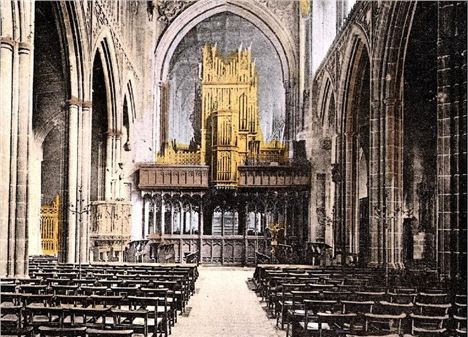MANCHESTER CATHEDRAL is to close next year between Easter and Christmas - from 3 April until 1 December.
The closure, subject to approval from the Cathedrals Fabric Commission for England, results from an unholy chill in the building.
"We have to always keep in the forefront of our minds, how does the Cathedral serve this city in the long term?"
In the blitz of December 1940, a large German landmine exploded in the north aisle of the church. Amongst British cathedrals only Coventry suffered more damage than Manchester. Although the late medieval wood carving and much of the fabric of the building miraculously survived, the organ on top of the screen was destroyed.
 Cathedral organ on the choir screen prior to 1940 destruction
Cathedral organ on the choir screen prior to 1940 destruction
The Cathedral now has the money in place to put an English-made organ back on the choir screen. The cost will be £2.1m. But before that can happen the Cathedral wants to ensure urgent work needed with the underfloor heating takes place.
This requires the insertion of a new system and the complete lifting of the floor across the church - Manchester Cathedral has the widest nave in the country. The dusty and mucky work needs to be completed before the delicate apparatus of a brand new organ is installed.
At present the heating of the Cathedral only operates at 15 per cent capacity - the solder on the copper pipes inserted during the post-WWII repairs having failed. The work is so extensive because the underfloor heating was laid in places under eighteen inches of concrete. The total cost of the work will be £2.2m.
An intriguing aspect of the new work is the geothermal solution. Boreholes will be drilled deep into the earth and the heat from the geology under Manchester, used to provide 80 per cent of the Cathedral's heat.
Anthony O'Connor, The Director of Fundraising and Development, describes the choices faced by the Cathedral. "We knew we had to complete this work before installing the organ, so we were faced with a couple of options. The heating could be repaired in stages over two years but this would severely affect services and prevent any large events taking place. Or we could close for eight months and work day and night and blast through it.
"We went with the second choice. Reluctantly. This has been a very, very tough decision. The Cathedral apart from very short periods (in WWII and after the IRA bomb) has offered upbroken worship for hundreds of years. Logically though, this provides the best and most efficient solution although it's been very difficult to swallow. We will try to soften the blow with open days, there'll be a webcam and we'll also install a viewing area, so people can still see inside our beautiful building."
 Nave beauty - the Cathedral as it is now, the lovely floor will have to be broken and replaced
Nave beauty - the Cathedral as it is now, the lovely floor will have to be broken and replaced
So what about services for the Cathedral congregation?
"Outside the west door on Victoria Street (the extension of Deansgate closed to traffic earlier this year) there will be a temporary wooden church built. There will be no break in services," says O'Connor.
Confidential regrets the closure but understands the reason. The wooden church is a splendid solution though.
In fact it could be an opportunity for an architect to create something truly beautiful, something that will really resonate with the Cathedral's origins. The earliest Saxon church more than a millennium ago and built on the present Cathedral site would have been timber, and wood is such a fine building material. Oxford Road Station provides the clearest evidence for this.
The work will also provide another opportunity.
"We will have the archaeologists in," says O'Connor. "We're wondering whether we'll find bodies we didn't know were there but also whether we'll find out more about earlier churches on the site. The area under the boxes close to the west door has never been opened up before. it's exciting."
O'Connor pauses before returning to the subject of the closure.
"We have to always keep in the forefront of our minds, how does the Cathedral serve this city in the long term? How can we best be part of Manchester, how can we help make it a better place? Well, first off we have to be welcoming. A cold place isn't welcoming. The work is part of making sure we remain central to worship in the city and also, with our events and our role as a tourist destination, an ambassador for it."
You can follow Jonathan Schofield on Twitter here @JonathSchofield
 Manchester Cathedral, the area in front of the tower will be the location of the temporary church
Manchester Cathedral, the area in front of the tower will be the location of the temporary church









